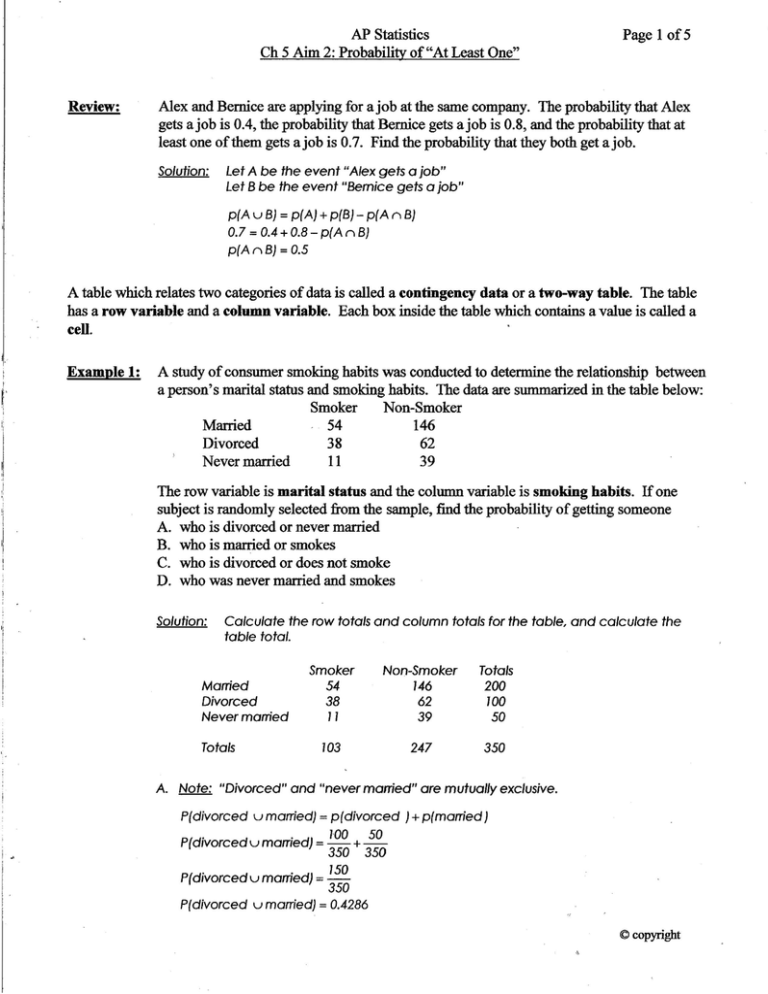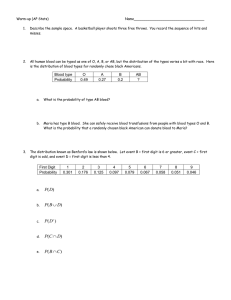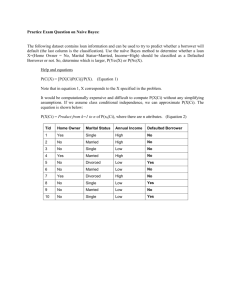AP Statistics Ch 5 Aim 2: Probability of "At Least One"
advertisement

AP Statistics
Ch 5 Aim 2: Probability of "At Least One"
Review:
Page 1 of5
Alex and Bernice are applying for a job at the same company. The probability that Alex
gets ajob is 0.4, the probability that Bernice gets ajob is 0.8, and the probability that at
least one of them gets ajob is 0.7. Find the probability that they both get ajob.
Solution:
Let A be the event "Alex gets a job"
Let B be the event "Bernice gets a job"
p(A v B) = p(A) + p(B) - p(A r, B)
0.7 = 0.4 + 0.8 - pi»: fl B)
p(A rv B) = 0.5
A table which relates two categories of data is called a contingency data or a two-way table. The table
has a row variable and a column variable. Each box inside the table which contains a value is called a
cell.
j.
':
Example 1:
A study of consumer smoking habits was conducted to determine the relationship between
a person's marital status and smoking habits. The data are summarized in the table below:
Smoker
Non-Smoker
Married
54
146
Divorced
38
62
Never married
11
39
The row variable is marital status and the column variable is smoking habits. If one
subject is randomly selected from the sample, find the probability of getting someone
A. who is divorced or never married
B. who is married or smokes
C. who is divorced or does not smoke
D. who was never married and smokes
Solution:
Calculate the row totals and column totals for the table, and calculate the
table total.
Married
Divorced
Never married
Smoker
54
38
11
Non-Smoker
146
62
39
103
247
Totals
A.
Totals
200
100
50
350
Note: "Divorced" and "never married" are mutually exclusive.
P(divorced v married}
=
p(divorced
) + p(married)
P(d·
d
. d} 100
50
tvorce v mame = 350 + 350
P(divorced v married}
= 150
350
P(divorced v married) = 0.4286
© copyright
Page 2 of5
AP Statistics
Ch 5 Aim 2: Probability of "At Least One"
B. Note: "Married" and "smokes" are not mutually exclusive! Use the Addition Rule.
P(married u smokes) = p(married) + p(smokes) - p(married n smokes)
.
200 103 54
P(mamed u smokes) = + -. -350 350 350
P(married u smokes) = 249
350
P(married usmokes) = 0.7114
C. Note:
"Divorced" and "does not smoke" are not mutually exclusive! Use the Addition
Rule.
P(divorced
u non - smoker)
.
P(dlvorced
- p(divorced n non - smoker)
100 247
62
u non - smoker) = +--350 350 350
P(divorced
u non _smoker) = 195
p(divorced
) + p(non - smoker)
350
u non - smoker) = 0.5571
P(divorced
I'
=
D. p(never married n smokes)
= _,_,
350
, p(never married n smokes) = 0.0314
Independent Events
Two events are independent if knowing that one occurs does not change the probability that the other
occurs.
Multiplication Rule for Independent Events
If A and B are independent, then
p(AandB) = p(A)· pCB)
pi A (I B)
Note:
Example 2:
= p(A)·
pCB)
"and":::::::;>
"multiply"
"or":::::::;>
"add"
Suppose a coin is tossed twice.
A. Does the outcome of the first toss affect the outcome of the second toss?
B. What is the probability of getting two heads?
Solution:
A. No, the tosses of a coin are independent.
B.
Let Hi be the event "Heads on the ith toss"
p(H, nH2)=p(H,)·p(H2)
1 1
p(H, nH2)=
2·"2
p(H, n H2)
= 0.25
© copyright
,
AP Statistics
Ch 5 Aim 2: Probability of "At Least One"
Example 3:
Page 3 of5
A general can plan a campaign to fight one major battle or three small battles. He. believes
that he has probability 0.6 of winning the large battle and probability 0.8 of winning each
of the small battles. Victories or defeats in the small battles are independent. The general
must win either the large battle or all three small battles to win the campaign. Which
strategy should he choose?
Solution:
Let S; be the event "win the ith small battle"
p(win
p(win
p(win
p(win
all 3 small battles) = p(S, rl S2 n S3)
0113 small battles) = P(Sl) . p(S2) .p(S3)
0113 small battles) = (0.8)(0.8)(0.8)
0113 small battles) = 0.512
Since the probability of winning one large baffle is higherYO.6), the general should fight
the one large baffle.
Probability of" At Least One"
Given the two events A and B, the probability that at least one occurs is pi.A u B) which can be
calculated by us~g the Addition Rule.
If there are n events which may occur, then the sample space for the possible number of events which
could occur is given below.
possible number of events which could occur = {0,1,2,3 ...n -1,n}
The outcomes which satisfy the condition "at least one" occur would be 1,2,3 ... n. The probability of at
least one occurring could be obtained by adding the individual probabilities for 1,2, 3 ... n, but it is much
., easier to subtract the one probability of the one outcome we do not want (0) from 1. (Recall that the sum
of the probabilities of a sample space is 1)
"At least one" => "one or more"
The complement of "at least one" is "none". Therefore,
peat least one) = 1 - p(none)
Note:
Example 4:
The complement of an event A is written A and means "notA".
A couple has decided that they want to have three children. Assuming that the
probabilities of having a boy or girl are equal, fmd the probability that the couple have
A. no boys
B. at least one boy
Solution:
A. p(noboys}
= p(G,
nG2 nG3)
1 1 1
p(noboys)
=2·2·2
p(no boys)
= 0.125
© copyright
AP Statistics
Ch 5 Aim 2: Probability of "At Least One"
B.
Example 5:
Page 4 of5
=
possible number of boys {O, I, 2, 3}
The outcomes which satisfy "at least one" are in bold print. Instead of adding the
probabilities of the desired outcomes, it is easier to calculate the probability of the one
outcome which is not wanted and to subtract this probability from 1.
p{at least / boy) = /- prOboys)
p{at least / boy) = /- 0./25
(From part A)
p{at least 1 boy) = 0.875
An automobile manufacturer buys computer chips from a supplier. The supplier sends a
shipment containing 5% defective chips. Each chip chosen from this shipment has
probability 0.05 of being defective, and each automobile uses 12 chips selected
. independently. What is the probability that all 12 chips in the car will work properly?
What is the probability that at least one of the 12 chips is defective?
Solution:
Let D represent "defective" and D represent "not defective"
p{D) = 0.05
p(DJ = 0.95
p{all chips work properly)
= p{all
chips are not defective)
p(all chips work properly)=p(D/)·p(D2)···p(D/2)
p{all chips work properly)
p(all chips work properly)
p(at least one defective)
p(at least one defective)
p(at least one defective)
, Example 6:
= (0.9512
= 0.5404
p(none are defective)
= 1-0.5404
= 0.4596
= /-
A string of Christmas lights contains 20 bulbs. The bulbs are wired in series, so that if any
bulb fails the whole string will go dark. Each bulb has probability 0.02 of failing during a
3-year period, and the bulbs fail independently of each other. What is the probability that
the string of lights will not light during the next 3 years?
Solution:
Let Frepresent "the bulb fails" and
p(F) = 0.02
p(fJ = 0.98
f represent "the bulb does not fail"
p(af least one fails) = 1-p(none fails)
p(at least one fails} = 1-p(~
/I f2 •.. /1 f20)
plat least one fails) = 1 - (0.98)20
p(at least one fails) = 0.3324
Example 7:
A diagnostic for the presence of the AIDS virus has probability 0.005 of producing a false
positive. That is, when a person free of the AIDS virus is tested, the test has probability
0.005 of falsely indicating that the virus is present. If the 140 employees of a medical
clinic are tested and all are free of AIDS, what is the probability that at least one false
positive will occur?
©copyright
AP Statistics
Ch 5 Aim 2: Probability of "At Least One"
Solution:
Let Frepresent "false positive" and F represent "not
p(F} = 0.005
p(F} = 0.995
Page 5 of5
a false positive"
plat least one false positive}
= 1- p(no false positive s)
p(at least one false positive}
= 1-p(F, n F2... nF140}
plat least one false positive) = 1- (0.995/40
plat least one false positive) = 0.5043
Example 8:
The Federal Railroad Administration found that human error was cited as a cause in 24%
of all derailments for a year. A railroad safety specialist randomly selects records from 5
different derailment incidents. What is the probability that at least one of the 5 derailments
was caused by human error?
Solution:
Homework 50:
Let H represent "human error" and H represent "not
p{H) = 0.24
p(Fi} = 0.76
a human error"
plat least one human error)
=
1- p(no human error}
p(at least one human error}
=
1-p(H, nH2 ···nHs)
p(at least one human error)
plat least one human error)
=
1- (0.76}s
0.7464
=
Sullivan's Statistics: Informed Decisions Using Data
Read pages 275-281
pg 281-284
1,3,5,9, 10, 15,35
©copyright
At' ~-\~s-\\cs
\\\1.) \\ 'So <&o\u-\\ons
<:~)f=\,)~=-
!'S)Co)'I'B)~)\O)'\\) \2"$ .
\> C\= \) G-') -::. ~I\'2. Qf 2./3
+ ?l&) -\'(rflG-)
f> (F o tr): ?(F)
"'!;.-
$/\2.. -\- 4/\2
Y\z.
-
--:. %/\2.. gt 2/3
<.q) ~(A0?»-:."lt\)·\-:"t~}-~ll\ni). <"\0) ~<.~\)~) -:. ~ (1\\ k ~l~) - ~<..~C)~)
~(A\)\)) -=- 0:2.$ ~ O.~S - D.\S
0 ..<0 -: 0:'2.$ -\-C.~S" - ~LAn'O)
':; .0" S'5
~ (AO~-) : 0 ..\
~<'A.)+ '?l£»-"t~GB)
(\S)~(A\)~):.
O,:~s=,6-(OO . --\-?t~)- O,oS
?(~J:l o.zo
(~s)
..
.
..
L\g \~-1-\4 Lts"-G,Lt
g,SSO '-\13sfo \)'S'2..C>
=
~e\o~~o,,~
\...e..-.le.
~V'f~.'
SlS~L{
e.
'?»,t; l
t4 '1~'-\ gO'\1
\S)~Bt{
A.. 2.~)"o2
..
..........
..
<Z'
><.,S
'\$8
\'5381-1
\)lS<O
\)'\t; 3
\~"3.2..4 .
1>;4,(0
'l.qO\
L%~08
e.S3S"t .
.. \1j4~L.\
2ca)"O&CSO~':::;o1.8
c,
. ~SSO·
'2..81~·lb8.~
\S'3<i>L\
O·l.~I()&
.
C>.~2}il &'
....·19t;~:!H~~SSOH
-\- 28"10&
28){0&
.............................
__ __ ._-..
.---


